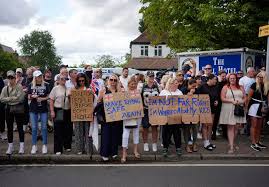
Introduction
The recent Epping protest has become a focal point in the ongoing discussion surrounding community engagement and environmental concerns in the region. Organised by local residents and community leaders, the demonstration aimed to raise awareness about planned housing developments that many believe threaten local ecosystems and the character of the neighbourhood. With growing public interest in sustainable living and responsible urban planning, the Epping protest is significant not only for the local community but also for similar initiatives across the UK.
The Details of the Protest
On Saturday, October 7, 2023, hundreds of residents gathered in Epping’s town centre, brandishing placards and chanting slogans calling for sustainable development. The protest, which was peaceful yet vibrant, featured speeches from local activists, environmental groups, and residents who shared their personal stories regarding the potential impact of the developments. The main concern centres on plans for high-density housing that some argue is not in line with the existing infrastructure and would lead to increased traffic and strain on local services.
Among the prominent speakers was Mary Johnson, a local councillor, who articulated the fears of residents regarding the loss of green spaces. “We need to preserve our environment and ensure that any development is in harmony with nature and meets the needs of the community without overwhelming it,” said Johnson.
Community Response and Future Implications
The turnout at the Epping protest illustrates a growing trend of community activism in urban planning discussions. Residents from all walks of life participated, indicating a broad consensus that development must be approached with caution. Many hope that their voices will prompt local authorities to reconsider the plans or at least engage in meaningful dialogue to address their concerns.
Furthermore, the Epping protest has garnered attention from local media, which may amplify the message of residents and encourage similar protests in other communities facing similar challenges. Engaging local authorities in discussions about development and environmental preservation appears to be a crucial next step.
Conclusion
The Epping protest serves as a reminder of the power of community engagement in shaping the future of urban environments. As the conversation about sustainable development continues to evolve, the significance of such protests cannot be underestimated. They not only highlight local concerns but also echo the demands for responsible planning practices nationwide. Moving forward, it will be critical for developers and planners to listen to community voices to foster developments that benefit both residents and the environment.
You may also like

Marie Hobinger: A New Force in Environmental Activism

David Lammy: Championing Justice and Equality in Politics
